Day 2 of a three day long weekend of Winter Tours in North Norfolk today. It was a nice dry and mild winter’s day, brighter in the morning though clouding over a little later on.
While we were loading up the car in Wells first thing this morning, we happened to scan the trees in a garden next to the road. A Coal Tit appeared in the top of an apple tree and, while we were watching it, a Waxwing popped up next to it. There have been lots of Waxwings about so far this winter, but most of those which arrived on the coast here have moved on inland. So this was most a welcome surprise.
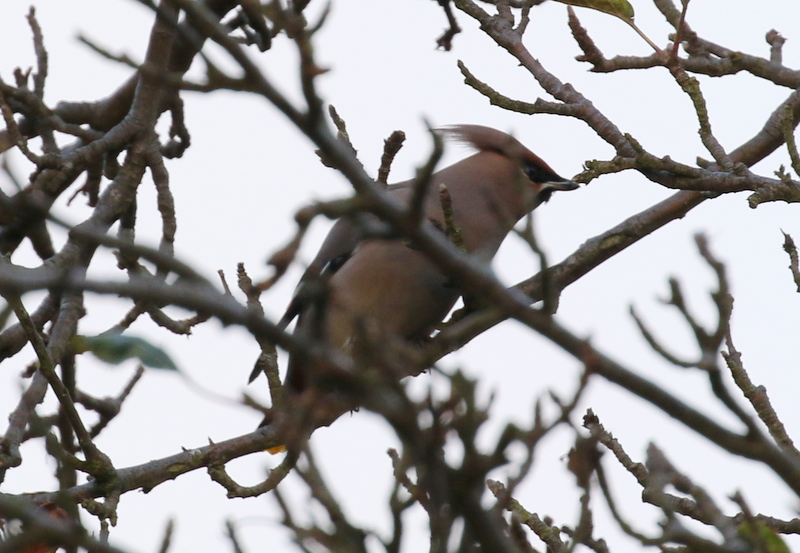 Waxwing – just one, in the centre of Wells briefly first thing
Waxwing – just one, in the centre of Wells briefly first thing
The tree was full of Blackbirds feeding on the apples still on the tree, and the Waxwing dropped down and joined in. It fed for a few seconds, then climbed up into the back of the tree. It was on its own and probably looking for other Waxwings – it called a couple of times. At that point, something spooked the Blackbirds and everything scattered. We waited a while for the Waxwing to come back down to the apples but we hadn’t seen where it had gone and there was no further sign of it. It had probably just dropped in to feed briefly, before carrying on its way.
While we were waiting, we did see a Brambling which flew down to the feeders in another tree in the same garden. Another nice surprise to start the day.
 Brambling – coming down to the feeders in the same garden
Brambling – coming down to the feeders in the same garden
Our first destination proper was Holkham. As we drove down Lady Anne’s Drive, there were a few flocks of Pink-footed Geese in the fields either side, so we pulled up for a closer look, admiring their pink legs and bill bands.
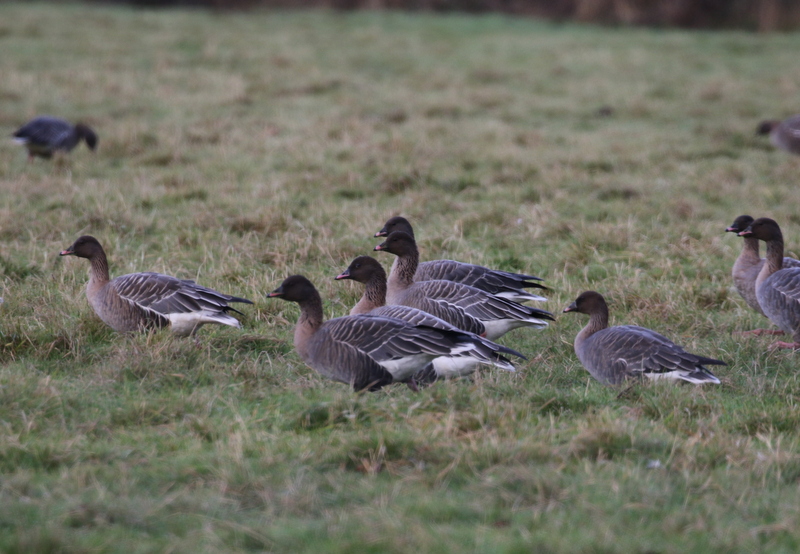 Pink-footed Geese – in the fields along Lady Anne’s Drive
Pink-footed Geese – in the fields along Lady Anne’s Drive
At the north end, a little group of Redshank were feeding on the pools in the grazing marsh on one side of the road and a large flock of Wigeon was out on the grass on the other side. Nearby, we found a single Curlew and a lone Common Snipe in the grass too. There was a bit of a commotion further over and we turned to see a male Marsh Harrier chasing a Carrion Crow. The Crow had something in its bill and obviously didn’t want to give it up. The two birds went round and round in tight circles for a minute or so, until the Marsh Harrier eventually gave up.
Walking out towards the beach, we could see a small group of Brent Geese out on the saltmarsh as we made our way down the boardwalk. One of the geese was subtly different from the others – darker bodied and with a more contrasting flank patch and a larger white collar. It was not dark enough for a pure Black Brant though. It was a Black Brant hybrid (the offspring of a Black Brant and a Dark-bellied Brent mixed pair), and it has been returning here for several years, presumably with the same group of Dark-bellied Brent Geese.
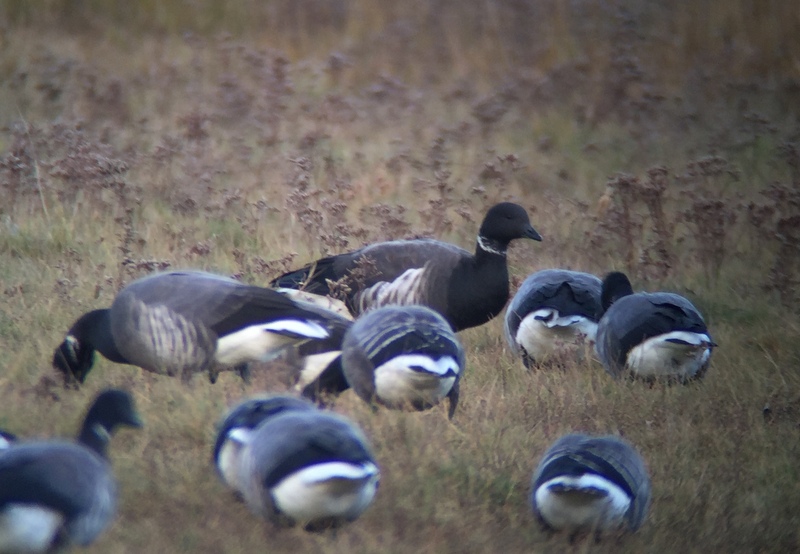 Black Brant hybrid – a returning bird with the Dark-bellied Brent Geese
Black Brant hybrid – a returning bird with the Dark-bellied Brent Geese
Right in the far corner of the saltmarsh, we found the Shore Larks. We could see them from some distance away, flying round, flashing white underneath as they turned. They landed again and we were able to approach carefully, stopping ahead of them and waiting as they worked their way towards us.
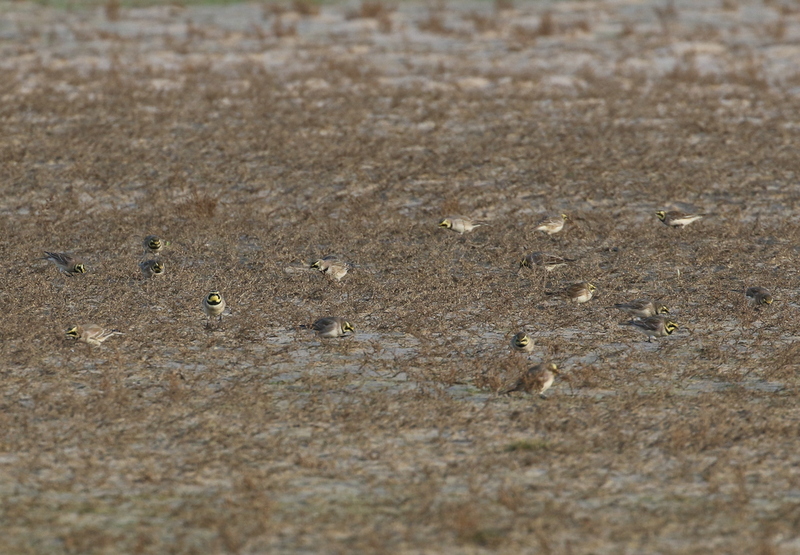 Shore Larks – some of the 28 at Holkham first thing this morning
Shore Larks – some of the 28 at Holkham first thing this morning
There were 28 Shore Larks in the flock today, while we were there at least. As they came closer, we had a great view of them in the scope. Their bright yellow faces shone in the morning sunshine, contrasting with the black masks. Very smart little birds!
 Shore Larks – the flock gradually came closer to us
Shore Larks – the flock gradually came closer to us
In the end, we had to tear ourselves away from the Shore Larks and walked out towards the dunes to look at the sea. Just about the first bird we found out on the water was a Red-necked Grebe. It was a little distant at first – thankfully it would come much closer inshore later. While we were trying to get everyone in the group onto it through the scope, a different bird surfaced in front. It was a Great Northern Diver. We all had a quick look at it before it dived.
The more we scanned the sea, the more we found. Not everyone had seen the Red-necked Grebe yet, and while scanning to find it one of the group found two grebes together. They didn’t sound like the Red-necked and taking a look through the scope they turned out to be two Slavonian Grebes. Then we found another Slavonian Grebe and another two, further out. Then a careful scan revealed at least 6 Slavonian Grebes scattered across the sea in ones and twos. A great number to find together in one place here at this time of year! There were lots of Great Crested Grebes out on the sea too.
The sea duck were further out today, and it took us a while to find a raft of Common Scoter. Looking carefully through the flock, we started to find a few Velvet Scoters in with them. The Common Scoter were almost all females, with large pale cheeks. Next to them, the Velvet Scoters looked much darker headed, with two smaller pale spots visible on a good view. It was not easy to pick them out at first, given the distance and the swell, but they drifted a bit closer inshore and the sea flattened off to make it a bit easier. In the end, we could see there were at least 10 Velvet Scoters out there today. A single Eider was similarly distant.
While we were watching the sea, we heard Shore Larks calling and a small group of nine flew along the beach and landed down on the sand in front of us. We presumed they were part of the group we had seen earlier, back on the saltmarsh, which had probably been disturbed by the increasing number of dogs out for a Saturday morning walk.
Four Snow Buntings had earlier flown east along the edge of the dunes. After the Shore Larks had moved on, another group of five Snow Buntings dropped down onto the tide line, where we could get a great look at them. One of them appeared to be an adult male Scandinavian bird, with lots of white in the wing.
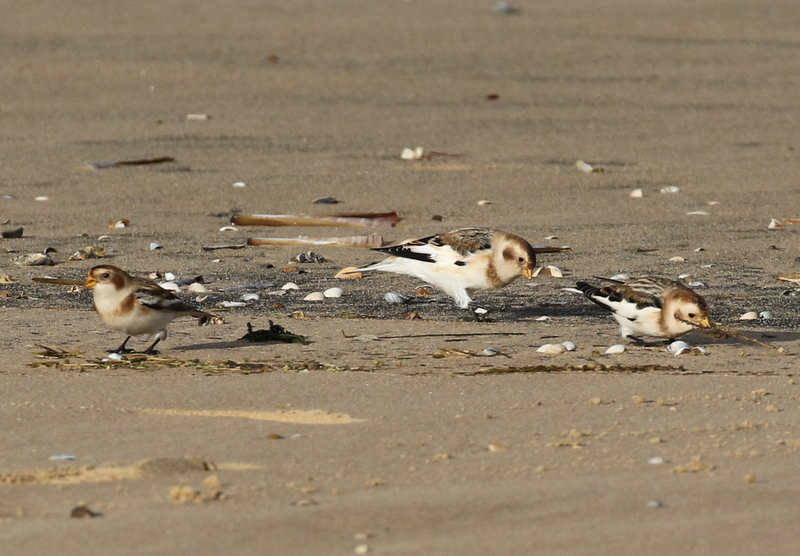 Snow Buntings – 3 of the 5 which landed on the tide line
Snow Buntings – 3 of the 5 which landed on the tide line
By this stage, the Red-necked Grebe had come closer inshore, giving us much better views. We could even see the yellow base to its bill, glinting in the sunshine! It gave us a better chance to compare it to the Slavonian Grebes, and the Great Crested Grebes as well. The Great Northern Diver had reappeared, at least we assumed it was the same one we had seen earlier, and for a few minutes it stopped diving and allowed us to get a great look at it too.
On our way back over the saltmarsh, we had a quick scan and there was no sign of any Shore Larks where they had been first thing this morning. We eventually stumbled across a small group, closer to the dunes, as we walked back. There were nine of them, so they were possibly the same birds we had seen out on the beach earlier. It seemed likely that the large flock had been disturbed and had disbursed. There were a lot of people out today, walkers and dog-walkers.
When we got back through the pines, we turned and walked west along the track on the south side of the trees. There were lots of Jays calling and flying back and forth across the path. At Salts Hole, we found a couple of Little Grebes on the water among the ducks. A Mistle Thrush flew out of the trees and dropped down onto the grass beyond. We could hear Long-tailed Tits calling and a tit flock duly appeared on the edge of trees. As well as a variety of tits, we could see lots of tiny Goldcrests flitting around. We heard a Treecreeper calling, and shortly after it appeared, working its way up the trunk of a pine tree. A Green Woodpecker flew off through the tree tops.
 Long-tailed Tit – we found a mixed tit flock on the edge of the pines
Long-tailed Tit – we found a mixed tit flock on the edge of the pines
We stopped briefly on the boardwalk by Washington Hide to scan the grazing marshes. A rather dark Common Buzzard was perched in a bush behind the reeds. A distant Red Kite circled over the trees in Holkham Park beyond. Four Gadwall were upending on the pool in front of the hide.
Making our way quickly further west, we climbed up to Joe Jordan Hide. Our first target was achieved as soon as we looked out of the flaps. A large flock of White-fronted Geese were out on the grass just to the left of the hide. We could see the white band around the base of the pink bill and the black belly bars of the adults. There were quite a few duller juveniles too. In all, we counted at least 96 White-fronted Geese here today.
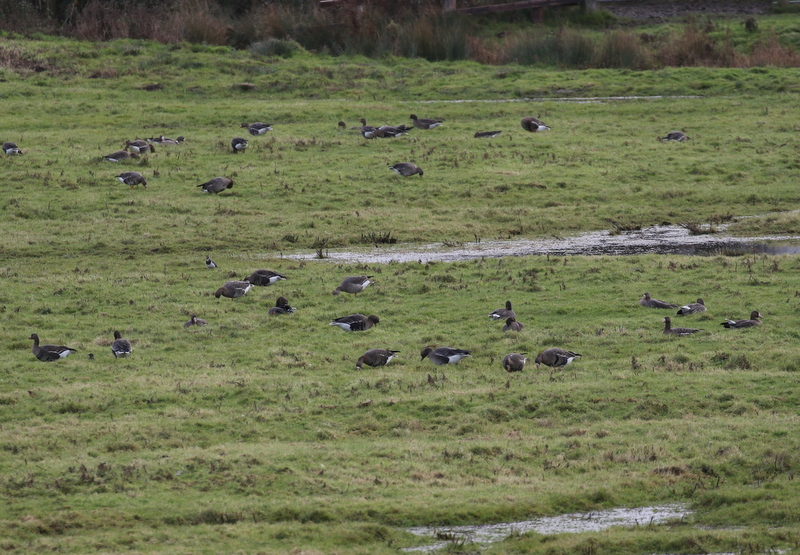 White-fronted Geese – there were at least 96 at Holkham today
White-fronted Geese – there were at least 96 at Holkham today
Before we had even had a chance to sit down, someone else in the hide pointed out a Great White Egret which had appeared on the edge of a reedy ditch. We got that in the scope next and had a great view of it, an enormous white bird, the size of a Grey Heron, with a long, pointed, yellow bill and black feet, distinguishing it from a Little Egret. The Great White Egret flew across and landed on an old bridge, where it stood preening for a while. Eventually it flew again and disappeared back behind the reeds.
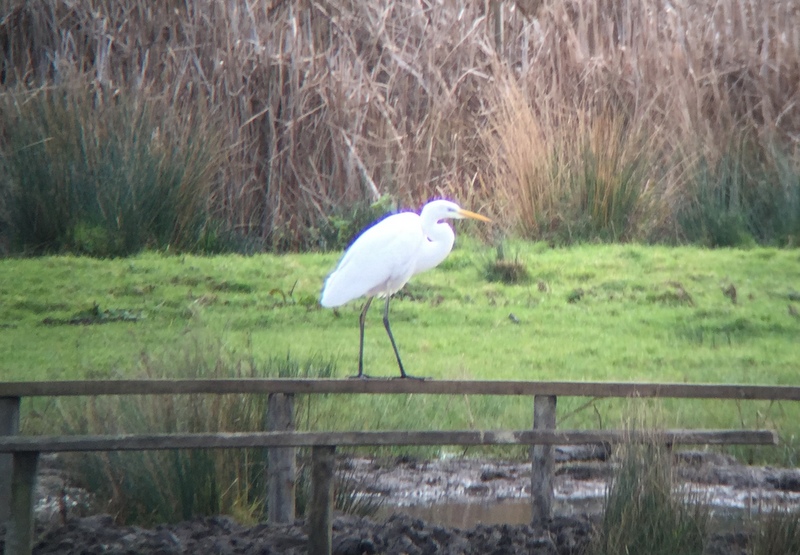 Great White Egret – out on the grazing marshes from Joe Jordan Hide
Great White Egret – out on the grazing marshes from Joe Jordan Hide
There were lots of Marsh Harriers out here too. At first, we could see a couple perched in the bushes, but then more appeared and the next thing we knew there were six Marsh Harriers circling together. One of them was carrying bright green coloured wing tags and when it landed we were able to read the code on them. It turned out the bird had been ringed several miles inland from here in the summer of 2015 and this was the first time it had been seen again!
It was time for lunch, so we made our way back to Lady Anne’s Drive and made good use of the picnic tables outside. After lunch, we drove west to Burnham Overy Staithe and made our way out along the seawall towards the dunes.
There were lots of Wigeon and Curlew out on the grazing marshes by the start of the seawall. Several Redshank and Grey Plover were feeding on the mud along the edges of the harbour channel and we counted at least 10 Little Grebes in the channel itself. As we turned the corner on the seawall, the larger area of open mud was covered in waders, predominantly Dunlin. On the grass the other side, lots of Brent Geese were busy feeding. A little further along, we stopped to look at a striking pale Common Buzzard perched on a post.
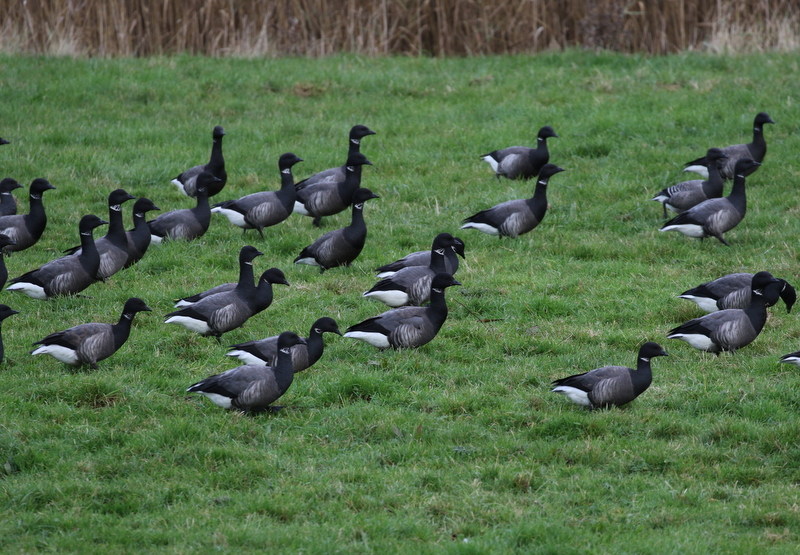 Brent Geese – lots were feeding on the grazing marshes by the seawall
Brent Geese – lots were feeding on the grazing marshes by the seawall
Once we reached the dunes, we made our way straight over to the beach. It had clouded over more now and, with the shortness of the days at this time of year, we were already starting to lose the light. There was no sign of the Isabelline Wheatear in the dunes around the end of the boardwalk as we walked past. It has seemingly been hiding out on the beach for the last couple of weeks, so we thought we would look for it out there, although we knew we were probably a little late in the day.
We walked quickly west along the tideline. There were lots of gulls out on the beach, a huge number of Common Gulls in particular, with more large groups constantly flying in to join them. There were a few waders too – a Bar-tailed Godwit, a handful of Ringed Plovers and Oystercatchers and a couple of Turnstones. What looked at first like a raft of scoter in the distance out on the sea turned out to be a large flock of Wigeon when we got them in the scope. Presumably they had been frightened off the saltmarsh, perhaps by a raptor, and had sought safety out here.
When we saw movement ahead of us on the beach, we looked to see six Shore Larks picking along the high tide line. We lost sight of them behind a ridge and walking on the next thing we knew they appeared right in front of us. They scurried ahead of us for a while, before flying up and doubling back, landing behind us back down on the tide line again.
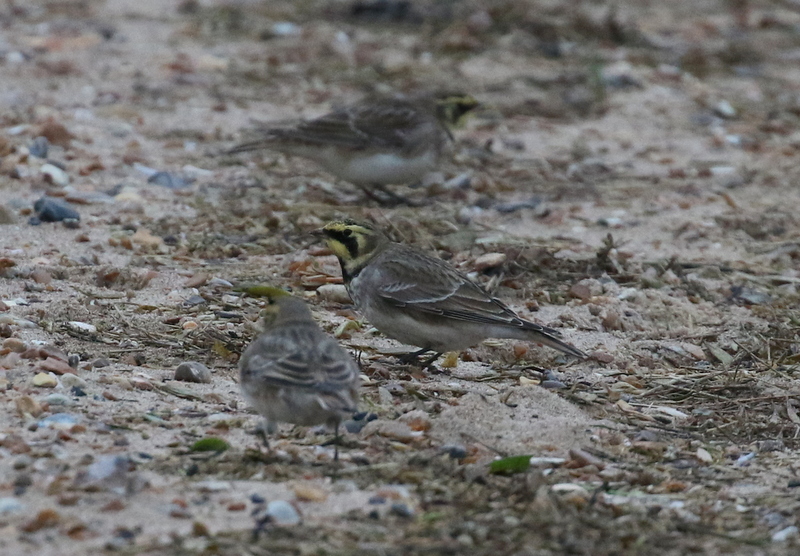 Shore Lark – six more were feeding along the tide line out at Gun Hill
Shore Lark – six more were feeding along the tide line out at Gun Hill
The bushes round Gun Hill were very quiet now and there was no sign of the wheatear in the dunes on the walk back to the boardwalk. From the seawall, we scanned either side on the way back to Burnham Overy Staithe. We picked up a distant grey male Hen Harrier over the saltmarsh, quartering low over the bushes. It seemed to drop down into the bushes, but the next thing we knew we picked up a grey male even further back, towards Scolt Head. Perhaps it was a different bird? The next thing we knew, a ringtail Hen Harrier was flying round with it.
With lots of yelping, we watched as a large flock of Pink-footed Geese dropped down off the fields and onto the grazing marshes. Even in the growing gloom, we could see there were several Barnacle Geese with them, although as usual there is no way of telling whether they might be wild birds or just part of the feral flock from Holkham.
It was the time when the Pink-footed Geese come in to roost at Holkham, and we looked up into the sky in the distance beyond and saw thousands and thousands of geese in a vast skein smearing the horizon. They were flying across from us, heading towards the back of Holkham Park. When we got back to the car park, we heard more geese yelping and looked up to see several more skeins of Pink-footed Geese coming in from the west. We loaded up the car as several more skeins passed overhead and then it was time to head for home ourselves.
















